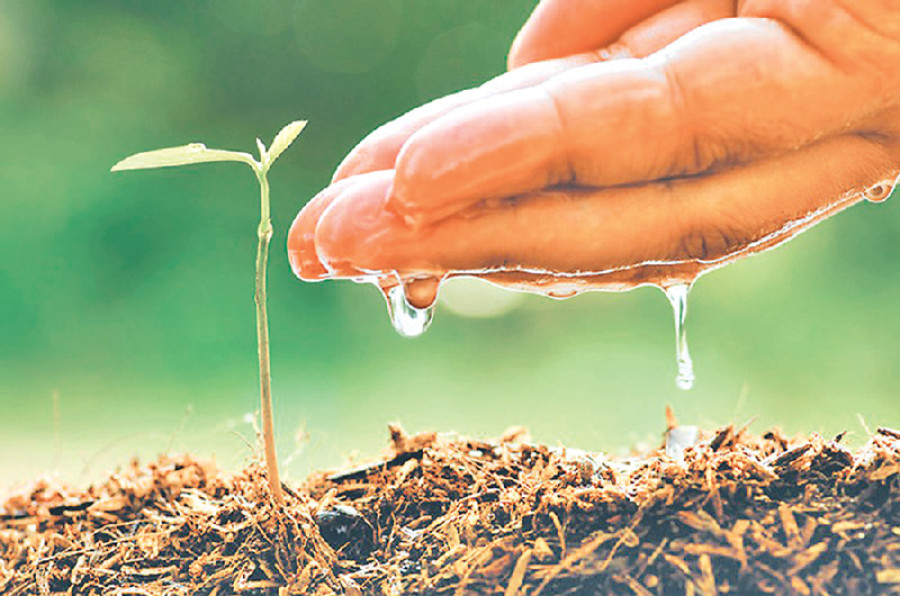Opinion
Super zones
Less than 20 percent of Nepal’s land area is cultivable, but 33 percent of the Gross Domestic Product (GDP) and 50 percent of the exports depend on the agriculture sector; it is a major source of food, income and employment for most of the people.
Yubak Dhoj GC
Less than 20 percent of Nepal’s land area is cultivable, but 33 percent of the Gross Domestic Product (GDP) and 50 percent of the exports depend on the agriculture sector; it is a major source of food, income and employment for most of the people. In recent days, the dependency on agriculture has declined from 90 percent to 63 percent, indicating that agriculture is gradually becoming specialised. Because of lack of assured and year-round irrigation facilities, farming is still heavily dependent on the monsoon. Agriculture is characterised largely by subsistence and mixed farming systems, and it is dominated by small landholders.
Boosting the agricultural economy
The seasonal nature of farming has led to widespread underemployment, but programmes to grow cash and high value crops have had some success over the years. Rice is the number one staple food crop having the largest share (21 percent) in the Agriculture Gross Domestic Product (AGDP). In 2015, farmers grew 5.2 million tonnes of rice on 1.6 million hectares of farmlands. It is clear that an increase in rice production has an impact on the national economy. Nepal’s rice requirement is about 5.6 million tonnes, which means it is close to reaching self-sufficiency.
Government efforts to boost the agricultural economy have focused on easing dependence on weather conditions, increasing productivity, and diversifying the range of crops for local consumption, export and industrial input. Solutions have included the deployment of irrigation, chemical fertilisers and improved seed varieties, together with credit provision, technical advice and limited mechanisation.
Concentrated efforts are necessary as farming has remained at the subsistence level for a long time, particularly in the hilly regions where peasants derive their living from fragmented plots cultivated in difficult conditions. Government programmes to introduce irrigation facilities, agricultural mechanisation, insurance and soft loans and fertilisers have proved inadequate as their delivery is hampered by the mountainous terrain. Population increases and environmental degradation have ensured that the minimal gains in agricultural production—owing more to the extension of arable land than to improvements in farming practices—have been cancelled out.
Since 1950, the country has practised several extension models and approaches with support from foreign donors and governments, namely T and V system, Integrated Rural Development Approach, Tuki Approach, Farming System Research and Extension Approach, and Block Production Programme. The Block Production Programme is based on the principle that intensive use of resources consolidated in an area can increase productivity. However, the major focus was laid on the production aspect rather than a holistic approach.
Specialised production system
Considering its importance, the government implemented the Prime Minister Agriculture Modernisation Project (PMAMP) in 2015. The project aims to specialise the production system based on concentrated efforts at various stages ranging from production to processing and marketing. It has envisioned a holistic system of specialised production by linking it with science, industry, modernisation and diversification. Under this project, agricultural land will be categorised based on productivity. In each district, a specialised production area will be determined and classified under four categories such as pocket, block, zone, and super zone. Farming may be undertaken without leasing the land.
A total of 2,100 agricultural pockets of 10 hectares each, 150 agricultural blocks of 100 hectares each and 30 production zones of 500 hectares each will be established in each district in the first year. Likewise, seven super zones will be established, one in each province. These production units will be increased annually based on need and justification. A super zone for rice has been established in Baniyani, Jhapa in Province 1, a super zone for fish in Bara in Province 2, and super zones for potato and vegetables have been established in Kavre and Kaski districts respectively. Similarly, Jumla, Dhangadhi and Dang districts have been selected as super zones for apple, wheat, and maize in Provinces 7, 6, and 5 respectively. Two super zones in Dhangadhi and Jhapa districts have been inaugurated by the prime minister as a symbolic initiation of commercialised and scientific agricultural programmes in the country.
Besides launching regular and focused programmes, the government has expressed its commitment to make the country self-sufficient in food. It has already announced that the production of wheat and vegetables in the coming year will reach a surplus. Similarly, Nepal has declared that it will attain self-sufficiency in rice in three years, and in fish and other commodities in the near future. It is interesting to note that “dreaming without sleeping but standing may yield the desired results”. This is not that difficult. We can make this quotation come true when the production mechanisms and systems at home and neighbouring countries are favourable.
GC is secretary at the Ministry of Livestock Development




 14.83°C Kathmandu
14.83°C Kathmandu












